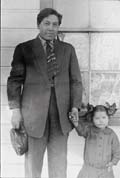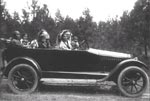 |
| Chief Joseph Seltice and daughter Clara, ca. 1920 |
With the Indian Reorganization Act of 1932, the Self-Determination Act of 1975 and the Self-Governance Act of 1995, American Indian Tribes and the United States government have entered into a new relationship. The effects of these acts sought to reverse decades of federal assimilation policies and acknowledge the sovereign rights of Tribes to govern themselves. The IRA formally ended the devastating allotment process, and provided religious and cultural freedom so long forbidden for government decree. The 1930's also saw the Jesuits ease their repressive policies, as "traditional forms of arts and culture" were encouraged by the priests.
While electing to exclude itself from many of the provisions of the IRA, the members of the first Coeur d'Alene Tribal Council were elected in 1936. This council was made up of Chief Joseph Seltice, Sam Friedlander, Albert Payne, Ike SiJohn, Paschal George, Basil Campbell, Ignace Williams, John Zachary and Basil Peone, who served as Chairman. As Peone stated, "A council form of government is only one of the few rights given an Indian tribe by law and when legalized the council is authorized to represent the entire tribe, for its common welfare. . . . We must concentrate on the possibility of reclamation of our lost rights, beneficial to our tribe, through amendments or repeal of agreements or treaties made with us" (January 18, 1936).
In 1947 the Coeur d’Alene Tribe established its own constitution, under which a council form of government would be followed. The council is made up of an elected chairman and six board members, each serving three-year terms. All enrolled members, with at least "one-fourth Coeur d’Alene blood" or by adoption, were entitled to vote and have a voice in tribal governance.
 |
| Entering the 20th Century - Wildshoe Family on a Drive, ca. 1910 |
Today the Coeur d’Alene Tribal government functions as any other sovereign nation. It has its own police force and court system (with judges, prosecutors and public defenders), along with 18 separate departments, such as Education, Social Services, Housing, Human Resources, Natural Resources, Economic Development Corporation and Legislative Affairs, each reporting to the Tribal Council. As a function of the Justice Department and with its own Police Department, the Tribe asserts civil jurisdiction over all inhabitants living within the reservation boundaries, while the U.S. federal government retains judicial responsibility over felony cases. Health care is also provided by the Tribe, having been transferred from the federal Indian Health Service to the Tribe’s state-of-the-art Benewah Medical Center and Wellness Center, both located in Plummer. In addition to public schooling, a Tribal School at DeSmet serves children of the elementary grade levels. As a policy of the Coeur d’Alene Tribe, these facilities provide educational, health and wellness services for all of the residents of the reservation, both Indian and non-Indian alike. A Tribally-run farm of some 6,000 acres is but one of the operations overseen by the Economic Development Corporation.
The Coeur d'Alene Reservation includes some 345,000 acres of land, of which over 80,000 acres are actually owned by the Schitsu'umsh (See the Allotment). The Tribal enrollment exceeds 1,825 members.
Coeur d'Alene Tribal Chairmen
|
Joseph Seltice - 1947-48
Joe Garry - 1948-49 and 1956-67
Paschal George - 1950-53
|
Felix Aripa - 1954
Lawrence Nicodemus - 1955
Oswald "Ozzy" George - Acting 1959, 1968-69
Bernard "Happy" LaSarte - 1970-71, 1974-1981, 1985
|
Hillary "Skip" Skanen - 1972-73
Dave Matheson - 1982-84
Ernie Stensgar - 1986-today
|
With the reclaiming of Tribal sovereignty, addressing and safeguarding the health of the people and the land are vital concerns for the Schitsu'umsh. The Coeur d’Alene Tribe has initiated very progressive natural resource assessment and management programs, as well as language and cultural site preservation endeavors. Continue your understanding on how Schitsu'umsh sovereignty is being reasserted today by visiting some of the contemporary Tribal programs on the following pages:
Coeur d'Alene Casino
Natural Resources Department
Language Center
GIS Names-Place Project
Benewah Medical and Wellness Centers
© Coeur d'Alene Tribe 2002
< previous |
next >
|



